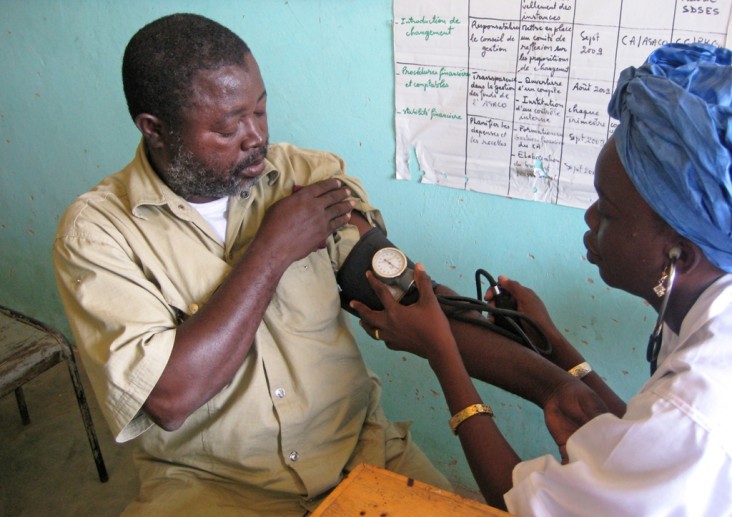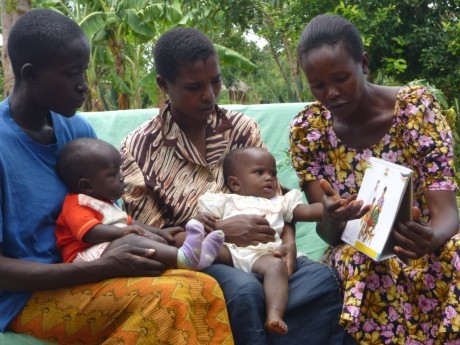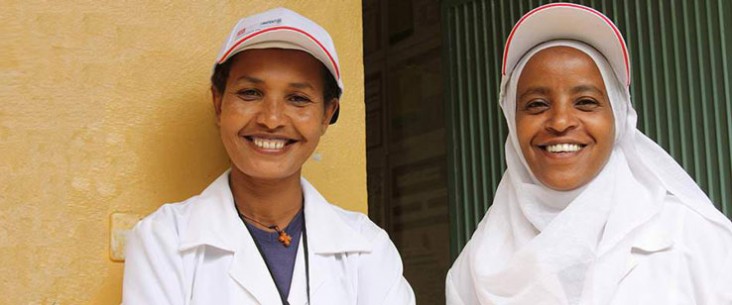- What We Do
- Agriculture and Food Security
- Democracy, Human Rights and Governance
- Economic Growth and Trade
- Education
- Environment and Global Climate Change
- Gender Equality and Women's Empowerment
- Global Health
- Humanitarian Assistance
- Transformation at USAID
- Water and Sanitation
- Working in Crises and Conflict
- U.S. Global Development Lab
Speeches Shim
The Path to an AIDS-free Generation
At a Glance
Progress toward an AIDS-free generation is dependent upon the ability of at-risk individuals and people living with HIV and AIDS to find and access quality health care, providers and products. A well-functioning health system meets these needs, effectively supporting prevention, care and treatment for HIV and AIDS. Building strong health systems is a crucial step on the path toward universal access to comprehensive HIV programs and a country-led, sustainable response to the epidemic. Unfortunately, many health systems are weak, overburdened and unable to meet the needs of the people they serve.
Six interconnected building blocks outline the functions of the health system:
- Service Delivery: delivery of effective, safe, high-quality health interventions to those who need them, when and where needed, with minimum waste of resources
- Leadership and Governance: ensuring strategic policy frameworks exist and are combined with effective oversight, coalition building, appropriate regulations and incentives, attention to system design and accountability
- Financing: mobilization of adequate resources from reliable sources, pooling of resources to foster efficiency and spread costs and allocation of resources to promote efficiency, equity and health impact
- Medical Products, Vaccines and Technologies: equitable access to essential medical products, vaccines and technologies of assured quality, safety, efficacy and cost-effectiveness, and their scientifically sound and cost-effective use
- Information: production, analysis, dissemination and use of reliable and timely information on health determinants, health systems performance and health status
- Human Resources for Health: ensuring a sufficient number and mix of staff and volunteers that are fairly distributed, efficient, responsive and competent to achieve the best health outcomes possible given available resources and circumstances
USAID’s Response
Under the 2008 reauthorization of the U.S. President’s Emergency Plan for AIDS Relief (PEPFAR), special emphasis was placed on strengthening health systems and workforce capacity and deeper integration of HIV and AIDS programs into health systems. This shift toward greater emphasis on sustainability and country ownership of the HIV and AIDS response has yielded significant gains against this global epidemic. The latest reauthorization of the U.S. President’s Emergency Plan for AIDS Relief (PEPFAR 3.0) reemphasizes data and accountability throughout all aspects of the global HIV response. As a key implementing agency of PEPFAR, the U.S. Agency for International Development’s (USAID’s) health systems strengthening (HSS) efforts enable PEPFAR to reach its ambitious targets for prevention, care and treatment.
USAID’s Office of HIV/AIDS engages in HSS in three ways:
- Focused interventions in HSS to address health system gaps specific to the achievement of PEPFAR and host country goals for HIV and AIDS prevention, care and treatment (for example, developing information systems to improve antiretroviral drug [ARV] delivery).
- Intentional spillovers, which are achieved when PEPFAR designs and implements HIV-focused activities in anticipation that these activities can and will benefit non-HIV and AIDS elements of the health system at no or very low additional cost (for example, capacity building for ARV procurement systems can also be used to purchase maternal and child health commodities).
- Targeted leveraging of funds, which is achieved by partnering with other development or entities to jointly sponsor broad-based health system improvement efforts that have an HIV and AIDS link (for example, joining other donors in developing a comprehensive national health insurance program that includes coverage for HIV and AIDS services).
The Office of HIV/AIDS collaborates closely with the Bureau for Global Health Office of Health Systems to help support HIV and AIDS and PEPFAR HSS efforts.
Current Programmatic Highlights

Monitoring HIV Policy
The USAID-funded Health Policy Project, in collaboration with the Centers for Disease Control and Prevention and the University of Washington, works to strengthen country ownership of and accountability for HIV programs through support to country stakeholders in the planning, implementing and monitoring of progress of policy intervention commitments in PEPFAR Partnership Framework Implementation Plans. Central to these efforts is the Road Map for Implementing and Monitoring Policy Interventions, a tool that strengthens the capacity of U.S. Government teams, partner governments and civil society organizations to monitor progress of policy interventions.
PEPFAR Expenditure Analysis
The PEPFAR 3.0 Report [PDF, 1.1MB], PEPFAR Blueprint: Creating an AIDS-free Generation and the PEPFAR Stewardship and Oversight Act of 2013 highlight the importance of improved collection and use of economic and financial data for increasing the efficiency, effectiveness and sustainability of HIV and AIDS programs. After extensive piloting during 2009-2012, PEPFAR institutionalized the Expenditure Analysis Initiative in fiscal years 2012 and 2013 across nineteen countries to routinely track expenditures of PEPFAR programs to:
- Provide a better understanding of the expenses the U.S. Government incurs to provide a range of HIV services;
- Improve accountability and oversight of PEPFAR efforts by tracking spending and accomplishments over time;
- Improve transparency, collaboration, and strategic planning with other stakeholders;
- Highlight areas for improved efficiency and improve alignment of future investments to program needs; and
- Estimate the resources needed to support future programs.
In its final phase of institutionalization, In FY 2014 PEPFAR will roll-out the Expenditure Analysis Initiative across its global portfolio to all operating units, which include thirty two countries and four regional programs. Expenditures are reported annually at the end of the USG fiscal year.
- Read the report on the pilot Expenditure Analysis [PDF, 242KB].
Human Resources for Health
To achieve an AIDS-free generation, USAID seeks to ensure adequate supply and quality of human resources for health to expand HIV/AIDS services to those most in need. USAID has been a significant contributor to PEPFAR’s achievements in strengthening the health work force to deliver quality HIV services. On World AIDS Day 2014, Secretary Kerry announced that PEPFAR has exceeded the target of 140,000 new health care workers, which was mandated by Congress in 2008. USAID is leveraging its past contributions and advancements in supporting implementation of the new PEPFAR Human Resources for Health (HRH) strategy in order to enable and sustain health worker's delivery of quality HIV services.
Under the direction of this new HRH strategy, we are working towards the following five objectives:
- Assess HRH capacity needs to deliver HIV/AIDS services.
- Support adequate supply and appropriate skills mix of health workers to deliver HIV/AIDS services.
- Establish recruitment, deployment, and retention strategies to ensure a consistent and sustainable supply of trained health workers.
- Establish sustainable financing for health workers, which ensures adequate local financing for health workers that provide HIV/AIDS services and sustained capacity for sites where PEPFAR salary support has been transitioned.
- Improve health worker performance for service quality.
Sustainable investments in HIV-focused community-based cadres
In South Africa, USAID has supported curricula development and accreditation processes to professionalize a newly introduced national community health worker cadre. To date, training has been provided to approximately 15,000 community health workers to better link communities to the health care system. The new cadre builds on gains made by PEPFAR in bringing HIV services to the community with the use of HIV lay counselors, peer educators and home-based caregivers. Many of these cadres that were initially developed in the emergency phase of PEPFAR have now been retrained as part of this national cadre and therefore fully integrated into the national health system. Aligned with the sustainable financing objective of the new HRH strategy, this work is a model for potential approaches to better integrate other partner-supported community-based cadres into national health systems. This is also aligned with the global Community Health Worker (CHW) partner commitments that USAID led development of at the 3rd global HRH forum.
Demonstrating the impact of comprehensive and strategic HRH approaches
USAID’s comprehensive HRH support and technical assistance led by the CapacityPlus and Uganda Capacity project with other partner engagement over the past five years in areas that include human resource management, strengthening the national HRIS, and support of rural retention studies, the government has been able to:
- Improve deployment of health workers throughout the country: the government increased the proportion of approved cadres filled in its 112 districts from less than 48 percent in 2009 to 61 percent by 2013; PEPFAR HRH investments are also facilitating the deployment of an additional 1,000 health workers to districts for three years starting in 2013
- Improve retention of health workers: the percentage of new health workers receiving their first payment within three months of recruitment increased from 32 percent in 2009 to 75 percent in 2013.
- Increase governmental resources towards the health workforce: in 2012, the government of Uganda increased the wage bill for the health sector by $19 million, permitting the recruitment of over 7,200 new professionals and raising staffing levels from 55 percent to 61 percent in 2013. This was achieved with no direct funding by the U.S. government and solely through technical assistance to Uganda’s Ministry of Health.
Improving HIV Service Quality and Outcomes

Building on USAID's history and leadership in application of modern improvement approaches in LMICs, the USAID-funded Applying Science to Strengthen and Improve Systems (ASSIST) Project supports the use of modern quality improvement (QI) methodologies by health care workers, producing evidence-based improvements in the implementation of AIDS-related services. Currently working in over 20 PEPFAR countries, these improvements directly relate to PEPFAR goals and objectives including increased compliance with clinical guidelines, increased efficiency and effectiveness, expanded coverage and scale-up of services, and patient-centered HIV care. An integral focus of ASSIST is institutionalizing ongoing improvement as an integral part of service delivery, a priority of the PEPFAR Quality Strategy. This work involves strengthening capacity for QI application at all levels of a country health system, which is essential for continued utilization of QI methods in HIV programs and sustained improvement of HIV service quality. ASSIST supports research and evaluation to further adapt modern QI to the needs of LMIC health systems and furthering south-to-south exchange amongst countries to ensure that knowledge gained from improvement activities is made available to others that might benefit.
- Read more about the USAID ASSIST Project Experience Improving HIV/AIDS service delivery.
Gender and Health Systems Strengthening
Gender-Based Violence Cost Calculator
USAID and the USAID-funded Health Policy Project (HPP) recently developed the GBV Program Cost Calculator, a tool designed to assist program managers, policy makers, donors and other stakeholders to estimate the cost of components of GBV-related clinical and community-based services. The tool reflects a comprehensive framework of GBV programs, with flexibility to respond to unique country priorities. HPP is currently using the calculator to conduct a study of discrete unit costs of providing GBV services in health care facilities in Tanzania.
- Learn more through the Gender and Health Systems Strengthening E-Learning Course.
This new electronic course developed by USAID-funded CapacityPlus offers a chance to learn about the gender issues that exist within the major health systems components, key interventions that promote gender equality and women's empowerment, and how to address gender issues in HSS activities in order to improve health systems and gender-related outcomes. Women and men have different opportunities, constraints, needs, power and access to resources affecting their health; thus, promoting gender equality in the six health system building blocks means assuring fairness and justice in the distribution of benefits, power and resources between women and men, girls and boys.
Additional Resources
- PEPFAR Human Resources for Health (HRH) Strategy [PDF, 748KB]
- Impact Blog: Invest in Health Workers to End AIDS
- Secretary Kerry’s Announcement on World AIDS Day 2014 of Training 140,000 New Health Workers
- Global Health Initiative Principle Paper on Health Systems Strengthening [PDF, 924KB]
- Sustainability and Country Ownership
- Public-Private Partnerships


Comment
Make a general inquiry or suggest an improvement.